Notice anything significant? Do we think this is just a coincidence? Or are doctor's able to do a better diagnosis when the children are 7 and 12, but have difficulty diagnosing them at 8, 9, 10, and 11? I wonder if these authors realize they have just added more support to the autism/immunization hypothesis. Do you think that maybe they are beginning to see the result of the recent research done by James, Deth, Hornig and others, and they know the previous position of 'no association is beginning to look problematic? Attached is a recently published study and some Power Point slides to accompany this study produced by Dr. Richard Deth, Northwestern University. This is a very powerful visual aid.
Trends in Diagnosis Rates for Autism and ADHD at Hospital Discharge in the Context of Other Psychiatric Diagnoses
David S. Mandell, Sc.D., William W. Thompson, Ph.D., Eric S. Weintraub, M.P.H., Frank DeStefano, M.D., M.P.H. and Michael B. Blank, Ph.D.
Psychiatr Serv 56:56-62, January 2005
© 2005 American Psychiatric Association
OBJECTIVE: Concerns have been raised over observed increases in the number of children who are given a diagnosis of a neurodevelopmental disorder. The goal of this study was to examine trends by age and calendar year in the diagnosis of two of these disorders, autism and attention-deficit hyperactivity disorder (ADHD), in the context of other psychiatric disorders in a sample of hospitalized children.
METHODS: Data from the Healthcare Cost and Utilization Project (HCUP) were used for descriptive analyses of secular trends of diagnosed psychiatric disorders between 1989 and 2000. Changes over time in rates of diagnosis of autism, ADHD, affective disorders, and substance-related disorders were examined and compared.
RESULTS: Substance-related disorders were the most common mental disorders recorded at hospital discharge and increased by 39 percent between 1989 and 2000. Affective disorder was the next most common diagnosis and increased by 138 percent. Although autism and ADHD were far less common, their diagnosis rates nearly quadrupled over the course of the study. Although rates of diagnosis of affective and substance-related disorders generally increased over the lifespan, diagnosis of autism and ADHD followed a very different pattern, with peaks in rates at ages seven and 12.
CONCLUSIONS: Increases in rates of diagnosis of etiologically unrelated mental disorders suggest that there have been changes in diagnostic practices over time, increases in community prevalence of these disorders, and increased likelihood of hospitalizations for different mental disorders.
News and commentary on the autism epidemic and my beautiful boy who is living with autism.
August 21, 2005
More Evidence of Harm
Observations by Lujene Clark of NoMercury and A-CHAMP. Look at these trends:
Subscribe to:
Post Comments (Atom)


No comments:
Post a Comment